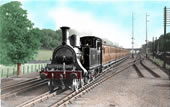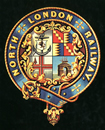
Society Tours
Ever since the Society was formed, we have endeavoured to arrange an outdoor guided tour each year, visiting locations relevant to the North London Railway, be they “pure” North London or those with which the NLR had associations – of which there were many. The tours provide a valuable opportunity to see and photograph fast-disappearing historic sites at first hand and hear authoritative commentary from our knowledgable members who lead them. A brief record of our tours so far is below with photographs taken at the time, some of which can no longer be taken...
1991
1) "All Stations to Poplar" visiting stations and station remains along the Broad Street to Poplar branch by minibus, a suitable form of flexible transport for the fledgling society.
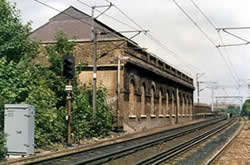
Hackney Station Rear: Hackney is the only NLR station building still surviving on the former Broad Street to Poplar branch and is virtually complete. This view is of the rear of the building, and one not easily photographed until the line was re-opened to passengers. It was taken from the platform of the adjacent new Hackney station.
2) "Ally Pally Walk". A walk along the trackbed of the former Great Northern Finsbury Park to Alexandra Palace branch, the Society’s first visit to the Northern Heights lines over which the NLR had running powers.
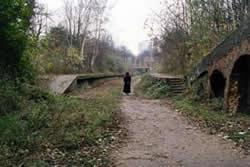
Crouch End Station: The track has long been lifted, but the platforms of Crouch End station still remained, slowly being consumed by nature. The station was closed to passengers in July 1954.
1992
1) Another “All Stations to Poplar” minibus tour, following the format of the 1991 tour.
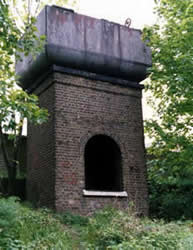
Bow Water Tower: This water tower stood on the embankment, in the cutting between Old Ford and Bow, unused for decades. It has since disappeared.
2) "Homerton and Stations West". A tour starting at Stratford and using the railway to visit Homerton, Hackney, Canonbury, Highbury and Camden Road stations.
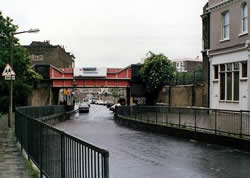
Homerton Station: The small section of brick wall to the right of the bridge is all that remains of the once magnificent Homerton station building, closed in 1944.
1993
Stratford to Kew Bridge. A tour by rail covering the NLR, HJR and NSWJR. Starting at Stratford, a number of places were visited including Camden Road, Acton Central, South Acton, Bollo Lane signal box, Gunnersbury, Kew Bridge, Hampstead, Dalston Kingsland and Dalston Junction, and Hackney.
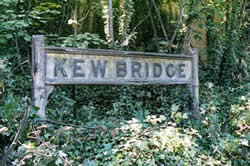
Kew Bridge Sign: A concrete station name sign still remained on the overgrown platform of Kew Bridge station, even though it was closed to passengers in September 1940.
1994
The ever popular “All Stations to Poplar” tour, this time in a vintage London Transport RF single deck bus, which allowed a greater number of participants. Every North London station and former station on the Broad Street to Poplar branch was visited, along with other sites of interest such as Poplar docks.
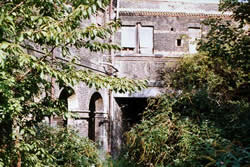
Dalston Eastern Curve: Dalston Junction station at track level, looking through the tunnel under Dalston lane, on the eastern curve towards Poplar. The track here was lifted in 1966, although the western curve was used for Broad Street to Richmond services until 1986. Remnants of the buildings at platform level are on the left.
1996
“City Extension Walk”. A tour along the remaining viaduct from Worship Street to Dalston, not at street level but along the top of the viaduct, by arrangement with Hackney Council. Access was also provided to the interior of Shoreditch station, affording a rare view of the booking hall, ticket office and stairs to the platforms.
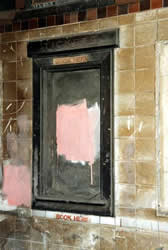
Shoreditch Ticket Office: Set into the tiled wall, the ticket office window of Shoreditch station, which beckons with the sign “book here” – 55 years after the ticket office was closed for the last time. The station is now a wine bar, the view gone for ever.
1997
London and Blackwall Walk. Tracing the NLR’s original route to the City until 1865: from the L&B’s Fenchurch Street station and walking to Limehouse, looking at the remains of various goods stations, the L&B viaduct, Leman Street station, Shadwell, Regents Canal dock and Limehouse; then by DLR to Poplar and Bow stations.
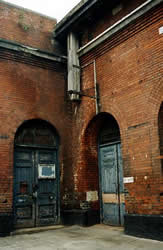
Shadwell Station: Shadwell station was closed in July 1941 but the street level buildings still orative exist. This is the entrance, but of particular interest are the remains of a signal post and a decorative gas lamp bracket.
1998
“Passing Old Ford”. A tour by rail from the original City terminus of the L&B’s Fenchurch Street to Richmond, via Limehouse and Stratford (omitting the section between Bow and Victoria Park via Old Ford, where there is no train service). With many diversions, involving much walking, to Bow station, Gas Factory Junction, Camden Road, Primrose Hill, Willesden, South Acton, Bollo Lane crossing, Kew East signal box, Kew Bridge and Barnes curve.
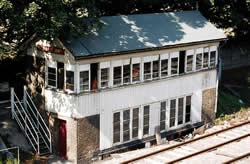
Kew East Signal Box: Photographed from the bridge parapet on the Great West Road, Kew East signal box nestles under the trees. Apart from the anti-vandal screen on the windows and the boarding up of the middle locking room window, the box is very much in original condition.
1999
Willesden Junction area. Although not part of the NLR, the area was central to its operations and, despite many changes in recent years, there was plenty to study. The walk covered an area bounded by Kensal Green Junction, Mitre Bridge, Acton Wells and Harlesden, including a walk along part of the Grand Union Canal.
2000
GNR Northern Heights. Studying the former LNER Highgate station and twin tunnels, then by Northern Line to look at East Finchley, Finchley Central, West Finchley, Woodside Park, Totteridge & Whetstone, and High Barnet.
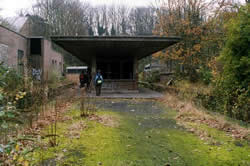
Highgate Station: Nestled deep in a cutting with tunnels at either end, and heavily overgrown, is Highgate station. This former LNER station was rebuilt in 1940/1 in connection with the LPTB northern extensions, in Highgate’s case to Alexandra Park, planned under the 1935 New Works Scheme, but which was never completed. The station was closed in 1954 and the tracks lifted in 1972.
2001
Poplar and Bow. A walk covering these history-rich but fast-changing areas once so important to the NLR, covering Poplar dock, Harrow Lane sidings area and goods office, Poplar station, Bow station, Bow works area, Gas Factory junction.
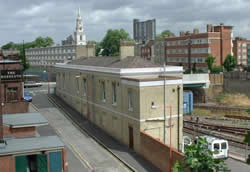
Harrow Lane Goods: The recently restored goods office at Harrow lane, Poplar, where there were once extensive goods sidings.
2002
Stratford to Feltham. A journey on the short-lived Anglia Railways service linking former GER towns on the Colchester main line to Basingstoke, via Stratford and the North London line. This was the only regular passenger service over the old NSWJR between South Action and Old Kew. The tour also took in Richmond, Gunnersbury and Kew East.
2004
Highbury and Islington to Hackney. By train and on foot, studying the stations and junctions, with lunch at Hackney station, now converted to the Hackney Central restaurant and including a tour of the upper storey.
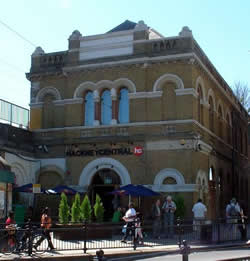
Hackney Exterior: Over 60 years since closure, Hackney station building is almost intact and is now a restaurant.
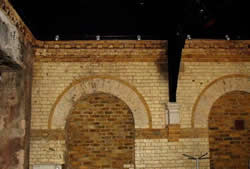
Hackney Interior: Detail of part of the interior of the upper floor of Hackney station, open to the public for the first time since the station was closed.
2005
Great Northern. The NLR ran a service from Broad Street to Gordon Hill on the former Great Northern Railway; this tour used the railway to cover the section from Gordon Hill as far as Finsbury Park.
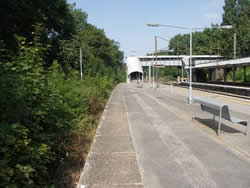
Gordon Hill: Gordon Hill station, looking to the north, showing the disused bay platform on the left, once the terminus of NLR services over the Great Northern.
2006
Stratford to North Woolwich. The North London was linked to Stratford and beyond by a connection at Victoria Park, opened by the Eastern Counties Railway as early as 1854, and both companies operated passenger and freight trains over the route. Today, North London Lines trains operated by Silverlink run from Richmond to North Woolwich but the section from Stratford to North Woolwich will be withdrawn later in 2006. The area is rich in history and, with now limited opportunity for a group to travel over this stretch, it was explored in some detail and included a visit to the North Woolwich Old Station Museum.
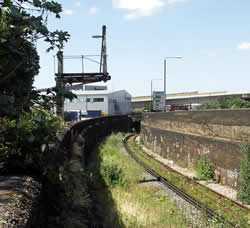
Silvertown Tunnel: Silvertown. The line descends into the tunnel built in 1880 to carry passenger trains under the connecting channel between the existing Royal Victoria Dock and the newly built Royal Albert Dock. The former high level line continued in use for freight over a swing bridge and the trackbed was on the immediate left of the retaining wall. Despite redevelopment, a derelict semaphore signal gantry, unused for decades, still stands.
2007
All Stations to Poplar. Beginning at Bishopsgate, where the East London Line Extension will connect with the original City Extension viaduct, various aspects of the viaduct were looked at as far as Shoreditch. The 1928 Shoreditch station building is now in use as a cafe and bar and it was possible to view the original staircase from ground floor to station level and a tiled walkway. Also visited was Hackney station, the most complete remaining NLR building apart from Camden Road, including the ticket office on the former connecting walkway to Hackney Downs; the remains of Bow station, with the connecting curve to Gas Factory Junction and the extent of the area formerly occupied by Bow Works; the remains of Poplar station; and the NLR dock area.
A stone NLR boundary marker in the City Extension viaduct. The details were never filled in, it seems.
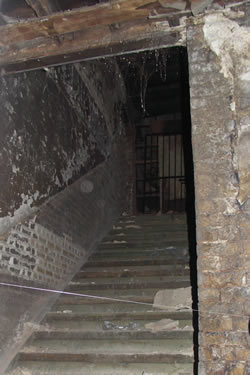
The upper staircase inside Shoreditch station, which formerly led to the platforms. The exit is now bricked up and there is no longer any access to what will become the East London Line.
The former exchange booking office building between Hackney NLR and Hackney Downs GER, situated close to Hackney Downs. The connecting walkway no longer exists, although there are some clues on the viaduct brickwork as to its position.
2008
“Up the Junction”. The Hampstead Junction Railway was a major extension of NLR services, opened in 1860 by the LNWR to reduce congestion near Camden Town. It ran from Camden Road via Gospel Oak, Hampstead Heath, Finchley Road & Frognal and Brondesbury to Willesden (Low Level). The LNWR provided the staff while the NLR provided the rolling stock. West End Lane (now West Hampstead) was opened in 1880. The route is still used for trains to Richmond and our tour looked at the stations on this important section of railway.
West Hampstead station street level building, opened in 1880 as West End Lane.
The diminutive Brondesbury Park station building, simple in design but enhanced with red brick window surrounds and dentil cornice.
2009
“Camden Railway Heritage Trail”. Camden has an industrial heritage rich in features associated with the 19th century and the arrival of the canal and railway. Peter Darley of the Camden Railway Heritage Trust led this fascinating tour, beginning with a detailed look at the interior of the Roundhouse. It covered all the features shown on the Trust’s excellent website (http://www.crht1837.org for full details) including the LNWR Interchange Warehouse and the vaults and arches under the NLR viaduct.
The LNWR Interchange Warehouse, viewed from the roving bridge over the Regent’s Canal. The entrance to the interchange basin, known locally as “Dead Dog Hole”, can be seen on the left where the towpath rises up and a barge is turning in the canal.
The buildings of the horse hospital, looking north. Statues of horses and other horse paraphernalia abound!
2010
“East London Line Extension” On the 23rd May 2010 the ELLE Phase 1 was opened, bringing into passenger use once more the NLR viaduct from Dalston to Shoreditch which had not seen rail traffic since the closure of Broad Street in 1986. The tour started at the new Dalston Junction station and focused on the new stations of Haggerston, Hoxton and Shoreditch as well as the refurbished East London Line stations north of the Thames. The Brunel Museum in Rotherhithe was visited and members had a then rare opportunity to enter Marc Brunel’s Rotherhithe shaft to the Thames Tunnel, “The Grand Entrance Hall”, closed to the public for over 140 years.
Dalston Junction station entrance on Dalston Lane is architecturally bland and barely recognisable as a station building, unlike its proud predecessor of 1865 which was setting the style for NLR stations to come.
However, the booking hall of the new Dalston Junction station is open, bright and airy.
2011
“Round The Horne”. Edwin Henry Horne was the architect for six of the NLR’s most magnificent stations at Bow, Hackney, Barnsbury, Canonbury, Camden Town and Highbury & Islington. Only Hackney and Camden still exist largely unaltered and only Camden is currently still in use as a station. The tour studied these latter two stations as well as the only remaining part of Canonbury – the recently restored station master’s house. The last vestigial remains of Highbury & Islington – a column of brick and Portland stone – was well photographed. A visit to Acton Central was also paid, which although not designed by Horne was very much in his style but on a smaller scale.
Camden Road, originally Camden Town when opened in 1870, the only Edwin Horne station still in railway use and largely complete, although missing its original roof with Horne’s trademark ornate ironwork decoration.
The last remains of Edwin Horne’s magnificent Highbury & Islington station which comprised an enormous two storey building with tall mansard roof and clock towers and incorporating a south wing which was the Cock Tavern and a north wing containing a parade of shops.
2012
“Ally Pally Walk”. The Great Northern Finsbury Park to Alexandra Palace branch, once served by NLR trains, was closed in 1954 after the 1935 New Works Scheme to electrify it and incorporate it into the Northern Line was abandoned because of the war and never revived. Now a popular and pleasant public walkway, Parkland Walk, this was one of the Society’s first walks in 1991. Stroud Green station master’s house, Crouch End station platforms, Highgate station with its twin bore tunnels either end and an intact Alexandra Palace station building were the highlights of the tour. The delightful Palace itself, with excellent views over London, was an added bonus to conclude the walk.
The platforms of Crouch End station. Despite being a public walkway, nature is endeavouring to reclaim what was once hers. Compare this view with that of the 1991 tour.
The south portal of the south tunnel at Highgate, also being claimed by nature.
Cable brackets dating from the abandoned pre-war New Works electrification scheme.
Alexandra Palace station building, beautifully restored and now in use as a community centre.
